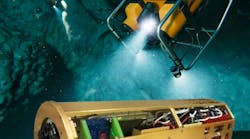EL SEGUNDO, Calif. – U.S. Air Force space warfare experts are reaching out to industry to find companies able to develop a system to plan and carry out space electromagnetic warfare operations.
Officials of the Air Force Space Systems Command at Los Angeles Air Force Base, Calif., issued a sources-sought notice (SP-2020-05) last week for the Space Electromagnetic Warfare Operating Location (SEWOL) project.
The SEWOL will be the Air Force's consolidated operating location for the planning, tasking and execution of space electromagnetic warfare operations.
Electromagnetic warfare uses focused high-intensity bursts of electromagnetic energy called electromagnetic pulse (EMP) to disable or destroy sensitive electronics like computers, networks, and sensors.
Related: Enabling technologies for airborne electronic warfare
EMP is a well-known byproduct of a nuclear explosion, which destroys electronics inside a wide radius by overwhelming it with high-energy electromagnetic pulses. This essentially fries electronics. Electromagnetic warfare seeks to focus and control these energy bursts to avoid widespread collateral damage.
The SEWOL will provide four primary functions. First, it seeks to create a space electromagnetic warfare common operating picture that displays information to system operators and on-site commanders.
Second, SEWOL seeks to create mission planning, execution, command, and control infrastructure and applications to refine tactical orders, plan for targets and weapons, and enable automated control of several different subsystems using one operator.
Third, the project seeks to create a remote space electromagnetic warfare physical and cloud computing infrastructure to operate a scalable number of subsystems remotely.
Finally, SEWOL seeks to create a mission resiliency and assurance infrastructure that not only will enable continuity of operations across all phases of conflict, but also use development, security, and operations (DevSecOps) to integrate cyber security and trusted computing.
The SEWOL initial baseline will include the space electromagnetic warfare common operating picture; secure communications for receipt of high-level tasking orders; local weapon system control; and remote weapon system control.
The SEWOL will have an initial operating location within the Continental U.S., which eventually will expand to several geographically dispersed operating locations.
The common operating picture will provide a visual, searchable, and interactive near-real-time picture of current global space electromagnetic warfare activities.
Related: Electronic warfare on the ground
The SEWOL will provide the infrastructure, cloud based, or bare-metal necessary to manage and remotely operate electromagnetic warfare systems from several geographic locations. This includes network infrastructure (NIPRnet, SIPRnet, and JWICS), processing infrastructure for space electromagnetic warfare systems, and a common operating interface.
Companies interested should email 10-page statements of capabilities no later than 21 Oct. 2021 to the Air Force's Doreen Barnett at [email protected]; Clifford Johnson at [email protected]; and Grace Machado at [email protected].
More information is online at https://sam.gov/opp/a4b67f8e42414a02b0bc34e4bf5b5c96/view.



